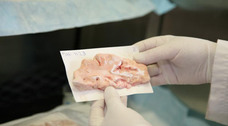2009-11-01

A team of neuroscience researchers at the Douglas Mental Health University Institute has discovered that the hippocampus, the part of the brain that is essential to organizing spatial and episodic memory, has been hiding its own clock.
The results of their study, published in the highly respected scientific journal Nature Neuroscience, could have a major impact on the way the production of some memories is studied.
This clock, better known as the theta rhythm, has long been of interest to scientists, since it has been clearly demonstrated that it plays a fundamental role in memory. For the past sixty years, it was believed that the rhythm of hippocampal neurons was controlled by extrinsic circuitry governed by nerve cells in the medial septum, near the hippocampus.
“Our experiments showed, rather, that the generator of hippocampal theta rhythms is actually buried deep within the hippocampus itself,” explains Sylvain Williams, Ph.D., the study’s principal author and assistant professor in McGill University’s department of psychiatry. This rhythm is created by the activity of thousands of neurons that deliver their messages, pause, and then resume their work, thereby initiating “waves” of energy (or brain waves) whose frequency can be measured. The frequency of the hippocampus – the strongest in the brain - is 7 Hertz.
This discovery redefines the role of the physiological interactions of the hippocampus and could assume its full importance in humans by identifying the markers of memory dysfunctions, as experienced, for example, by Alzheimer’s patients.
While earlier theoretical studies suggested the independence of the hippocampus, or the existence of this internal clock, no experiment had as yet confirmed it. Williams was able to conduct his experiments by applying a unique and innovative technique for observing the hippocampus that he himself developed along with the two students who co-authored the study, Romain Goutagny and Jesse Jackson.
The traditional observation method using brain slices did not allow researchers to measure the internal circuitry of the hippocampus and thus observe its rhythms. Using the intact hippocampus of animal models, Williams’ team was able to measure, in vitro, and by electrophysiology, long enough sequences of oscillations to observe that the hippocampus independently generated its own rhythm.
That these results have already garnered significant attention is evidenced by the fact that neuroscientist Edvard Moser and his colleague Laura Colgin, world leaders in the study of the brain, will discuss the impact of this discovery in the “News and Views” section of Nature Neuroscience.


